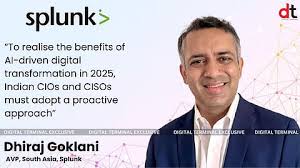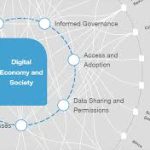In today’s rapidly evolving digital landscape, cybersecurity is no longer just about defense, it’s about resilience, intelligence, and adaptability. As AI takes center stage in transforming security operations, organisations must embrace innovative approaches to stay ahead of emerging threats. In an exclusive conversation, Rajeev Ranjan, Editor of Digital Terminal, engages with Dhiraj Goklani, AVP, South Asia, Splunk to explore how AI-driven innovations are reshaping cybersecurity, redefining governance frameworks, and enhancing digital resilience in 2025.
How do you foresee AI-driven innovations reshaping cybersecurity practices and enhancing organisational resilience in 2025, especially in the Indian market?
In 2025, AI will be more than a technological advancement in cybersecurity – it will be a fundamental requirement. AI-driven innovations will be essential for defending against increasingly sophisticated threats and reinforcing organisational resilience. Splunk’s Predictions 2025 report highlights how AI will transform Security Operations Centers (SOCs) by enabling intelligent threat detection, adaptive correlation, and proactive response. This will help security teams effectively manage incidents, stay ahead of evolving threats, and focus on critical priorities.
This is especially crucial for India’s rapidly expanding digital economy. Sectors like banking, insurance, healthcare, and government are undergoing significant digital transformation, making AI-driven cybersecurity solutions essential. Case in point, data from the Reserve Bank of India (RBI) shows over 14,000 banking-related scams were reported in the first half of FY24 alone, highlighting the urgent need for advanced security measures to protect financial institutions and consumers.
Splunk’s CISO Report indicates that 94% of organisations globally have experienced disruptive cyberattacks, emphasising the need for robust cybersecurity defences. AI’s ability in cybersecurity to anticipate and mitigate risks is key. AI-powered solutions can swiftly detect anomalies, prevent breaches, and flag potential incidents in real-time. Improving threat detection and response, these solutions help safeguard sensitive data and ensure compliance with evolving regulations.
Across industries – from banking and healthcare to government and retail – the convergence of AI and cybersecurity is driving a fundamental shift. By leveraging AI, organisations can improve their defences, adapt to emerging threats, and enhance enterprise resilience in an increasingly complex digital landscape.
What key trends are driving governments to redefine the materiality of cybersecurity events, and how should businesses align with these changes?
As governments increasingly confront serious cyber threats targeting their institutions and supply chains, there’s a notable shift in defining the materiality of these threats.
One key driver is the significant impact of major cyber incidents on critical infrastructure. Splunk’s report highlights that prolonged recovery periods can be recognised as critical markers of materiality. Focus on transparency and accountability will urge enterprises to address both immediate threats and underlying vulnerabilities.
To align with these changes, businesses must adopt more advanced tools and strategies. Splunk’s AI-powered observability solutions, for example, enable real-time monitoring of environments. By correlating security signals with emerging data patterns, organisations can proactively detect and respond to threats, minimising damage and downtime.
It is no surprise that Splunk’s recent research revealed that 90% of organisations experienced at least one major cyberattack in the past year, with 83% reporting ransomware payments. This highlights the necessity for governments and organisations to collaborate on establishing unified standards and enhancing cooperation. Ultimately, a collective effort is essential to fortify resilience against evolving cyber threats.
The report highlights the rise of domain-specific small language models (SLMs). How do you see these models complementing or competing with large language models (LLMs)?
Domain-specific compact language models (SLMs) represent a distinct approach compared to their larger counterparts, large language models (LLMs). Rather than competing, SLMs and LLMs offer complementary strengths, creating a powerful synergy for organisations.
As Splunk highlights, SLMs excel in speed and accuracy for targeted use cases, by focusing on specific domains, such as automating network configurations or optimising security operations. SLMs deliver highly efficient and reliable performance. This also minimises the risk of “hallucinations” – a known challenge with LLMs where inaccurate or misleading outputs can occur. SLMs’ reliance on focused datasets enhances their reliability, making them a cost-effective solution for precise operational needs. LLMs, on the other hand, remain invaluable for broader applications. Their strength lies in handling complex, cross-domain tasks – from strategic planning and data analysis to decision-making across organisational levels.
Together, they create a powerful, hybrid approach. Businesses can either embrace both to unlock a new level of operational efficiency and scalability in their AI initiatives or choose the right model based on specific business needs to automate processes, enhance efficiency, and effectively scale AI-driven initiatives.
What are the biggest challenges organisations face in balancing AI adoption with data governance and ethical considerations?
When it comes to AI adoption, a primary concern is ensuring data privacy and compliance. Splunk’s CISO Report highlights that 59% of organisations feel pressured to proactively address compliance issues due to increasingly stringent regulations across the globe. This is particularly complex in regions like APAC, where fragmented regulatory frameworks complicate governance efforts.
That said, the same report highlights that 59% of organisations are proactively addressing compliance amid tightening regulations. In regions like APAC, fragmented rules increase the need for oversight to avoid governance failures. One way for teams to better align data practices with regulatory and ethical standards is to break down team silos by consolidating tools.
Mitigating bias in AI models is another challenge. Since these systems are often trained on large datasets, which in turn potentially contain implicit biases, ensuring fairness and transparency in AI outputs is critical. Bias undermines AI-driven decisions, risking erroneous business decisions, reputational damage and legal repercussions. Seamless unification with legacy systems and current governance frameworks is paramount as organisations adopt AI for efficiency and innovation.
As digital resilience becomes a critical focus, what role does real-time data analysis play in ensuring businesses can adapt to rapidly evolving threats and opportunities?
In Splunk’s Cost of Downtime report, we learnt that downtime costs Global 2000 organisations nearly $400 billion annually. Real-time data analysis is crucial for proactive monitoring and rapid response, minimising disruptions before they impact the bottom line.
A notable example of Splunk’s support for real-time data analysis is its collaboration with DANA, one of Indonesia’s leading digital payment platforms. Serving over 135 million users, DANA prioritises service availability and reliability. By implementing Splunk Observability Cloud, DANA shifted from reactive, fragmented monitoring to a proactive observability strategy. This shift has enabled DANA to perform real-time data analysis by fully tracing every transaction, allowing the platform to detect anomalies as they occurred. With this capability, DANA was able to swiftly address potential threats, reducing incident recovery times by up to 90%. As a result, DANA was not only able to enhance its business resilience and ensure operational stability but also deliver exceptional customer experiences by acting on real-time data insights to improve service continuity and performance.
What are the top two pieces of advice you would offer to Indian CIOs and CISOs planning to adopt AI in their digital transformation journey, based on the key trends expected to dominate in 2025?
To realise the benefits of AI-driven digital transformation in 2025, Indian CIOs and CISOs must adopt a proactive approach.
The first is to prioritise ROI-driven AI initiatives. Beyond experimentation, the need to focus on use cases that deliver measurable business value, improving operational efficiency, security, and the bottom line will soon be a necessity.
The second is to foster collaboration and cross-functional alignment, such as the need to align security goals with overall business objectives. To achieve this, the collaboration among boards, legal teams, and operational stakeholders to develop a holistic digital resilience strategy is required. Involve diverse teams in the AI adoption process to ensure compliance, smooth integration with existing governance frameworks, and building overall digital resilience with a unified approach.
By focusing on these two key areas, Indian CIOs and CISOs can harness AI’s transformative power while mitigating potential risks. This focused approach will pave the way for resilient, future-ready enterprises equipped to thrive in the evolving digital landscape.







